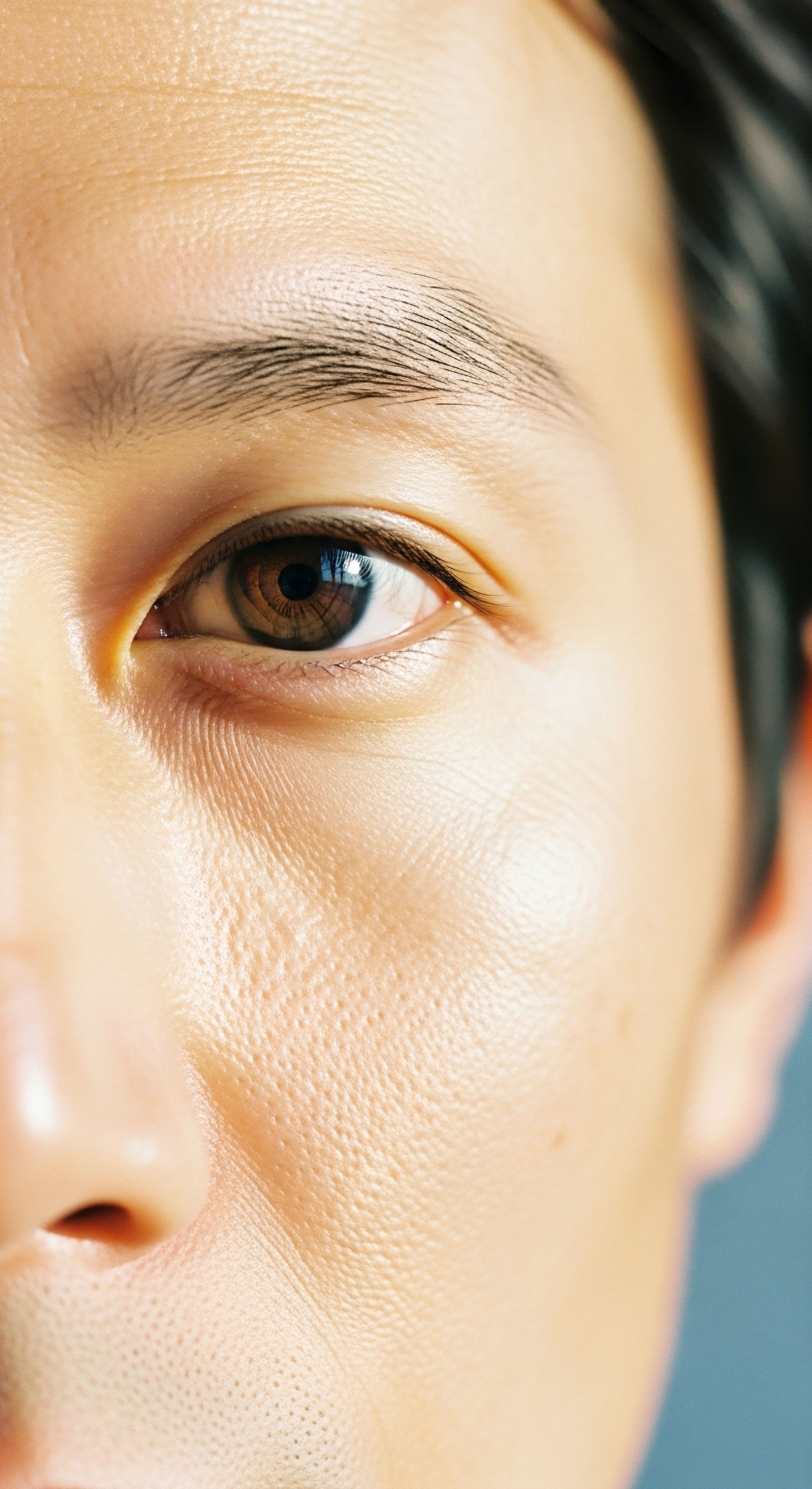

Fundamentals
You notice a change in your skin. Perhaps it’s a persistent lack of radiance, a sudden bout of acne along the jawline that feels unfamiliar, or the deepening of fine lines that seems disconnected from the number of candles on your last birthday cake.
This experience, this visible shift in the texture and behavior of your skin, is a deeply personal and often frustrating biological narrative. Your body is communicating a change, and the skin is its most visible language. Understanding this language begins with recognizing that your skin is an active participant in your body’s endocrine system, a complex network of hormonal communication.
The skin is not merely a passive barrier to the outside world. It is a dynamic endocrine organ, both producing and responding to hormonal signals. Think of hormones like testosterone, estrogen, and cortisol as internal messengers, carrying instructions that dictate cellular behavior throughout your body.
In the skin, these messengers regulate everything from oil production in the sebaceous glands to the synthesis of collagen and the lifecycle of skin cells. When this internal communication system is balanced, the skin reflects it with clarity and resilience. When the system is disrupted, the skin often shows the first signs of this internal discord.
Your skin’s health is a direct reflection of the complex dialogue between your internal hormonal state and your external environment.
This is where the environment enters the conversation. The world around you is filled with signals that your body must interpret. These signals are not just sunlight and temperature; they include a vast array of man-made chemicals and stressors that can interfere with your delicate hormonal symphony.
These compounds, known as Endocrine-Disrupting Chemicals (EDCs), are found in everyday items like plastics, cosmetics, and pesticides. They possess the ability to interact with your body’s hormone receptors, sometimes mimicking your natural hormones and other times blocking them entirely. This interference sends confusing messages to your cells, including the highly responsive cells of your skin.
The result is a tangible change in your skin’s appearance and health. An influx of signals that mimic androgens can lead to increased sebum production and inflammatory acne. Other environmental exposures can disrupt the signals that command collagen production, accelerating the visible signs of aging.
Your personal experience of skin changes is the physical manifestation of this intricate interaction between your unique genetic makeup, your internal hormonal milieu, and the constant stream of information from your environment. Acknowledging this connection is the foundational step toward understanding the root cause of your symptoms and reclaiming control over your biological well-being.


Intermediate
To appreciate how environmental factors translate into visible skin changes, we must examine the specific mechanisms at play within the skin’s cellular machinery. The interaction is a sophisticated biochemical process where external molecules are interpreted by your body, often leading to unintended hormonal consequences. This process centers on the disruption of finely tuned feedback loops that govern your endocrine health.

How Environmental Signals Hijack Hormonal Pathways
Endocrine-Disrupting Chemicals (EDCs) are a primary vector for environmental influence on skin health. These molecules are structurally similar enough to our own hormones that they can fit into cellular receptors like a poorly copied key. Once bound, they can either illicit an inappropriate response or block the intended hormone from delivering its message. This creates a state of cellular confusion that manifests in various skin conditions.
Consider the androgen receptors in your skin’s sebaceous glands. These receptors are designed to respond to hormones like testosterone. Certain EDCs, such as Bisphenol A (BPA) found in some plastics and phthalates used in fragrances, can act as androgen agonists.
They bind to these receptors and trigger an increase in sebum production and inflammation, contributing directly to the formation of hormonal acne, particularly in the lower face and jawline. The body is, in effect, receiving an androgenic signal from an external, non-hormonal source.
Chronic exposure to environmental stressors can systematically dismantle the skin’s structural integrity by disrupting its hormonal and repair signals.
Another critical environmental factor is ultraviolet (UV) radiation from the sun. Beyond its direct DNA-damaging effects, UV exposure is a potent physiological stressor. This stress prompts the body to release cortisol, our primary stress hormone. Chronically elevated cortisol levels have a catabolic, or breaking-down, effect on the body.
In the skin, cortisol actively degrades collagen and elastin, the proteins that provide structural support and elasticity. Simultaneously, UV radiation increases the activity of enzymes called matrix metalloproteinases (MMPs), which further break down the dermal matrix. This creates a dual assault on the skin’s framework, accelerating the appearance of wrinkles and sagging.

Building Resilience through Hormonal Optimization
Understanding these mechanisms provides a clear rationale for proactive clinical strategies. If environmental factors are disrupting hormonal balance, then restoring and stabilizing that balance can build systemic resilience. This is a core principle behind hormonal optimization protocols.
- For women experiencing perimenopausal skin changes, which are often exacerbated by environmental stressors, protocols involving low-dose Testosterone Cypionate and bio-identical Progesterone can be transformative. Testosterone supports sebum quality and skin thickness, while progesterone can counteract some of the inflammatory effects of hormonal fluctuations. This recalibration helps fortify the skin against external disruptors.
- For men on Testosterone Replacement Therapy (TRT), optimizing testosterone levels helps maintain collagen density and skin integrity, offering a defense against the aging effects of cortisol and UV damage. The inclusion of Anastrozole to manage estrogen conversion is vital, as estrogen balance is also key to skin health in men.
The following table outlines common environmental disruptors and their specific impacts on skin, linking them to the hormonal pathways they affect.
| Environmental Factor | Common Sources | Hormonal Pathway Affected | Resulting Skin Condition |
|---|---|---|---|
| Phthalates | Synthetic fragrances, cosmetics, vinyl flooring | Acts as an androgen agonist; disrupts estrogen signaling | Hormonal acne, increased skin sensitivities |
| Bisphenol A (BPA) | Plastic containers, can linings, thermal paper receipts | Mimics estrogen; can act as an androgen antagonist | Disrupted oil balance, potential for inflammatory skin issues |
| UV Radiation | Sunlight | Increases cortisol; activates MMPs | Collagen degradation, accelerated aging (photoaging), wrinkles |
| Dioxins | Industrial byproducts, contaminated food | Activates the Aryl Hydrocarbon Receptor (AhR), cross-talk with hormone pathways | Chloracne, pigmentation disorders, skin aging |

What Are the Long Term Effects of EDC Exposure on Skin?
The cumulative effect of exposure to EDCs and other environmental stressors is a progressive decline in the skin’s ability to self-regulate and repair. Over time, the constant hormonal miscommunication can lead to chronic inflammation, a compromised skin barrier, and a depleted structural matrix.
This manifests as a constellation of issues ∞ persistent acne, rosacea flare-ups, hyperpigmentation, and a loss of firmness and elasticity that appears accelerated relative to chronological age. Addressing the root cause through both lifestyle modifications to reduce exposure and clinical protocols to restore hormonal stability offers a comprehensive strategy for long-term skin health.


Academic
A deeper, molecular-level investigation into the environment-skin-hormone axis reveals a central signaling hub ∞ the Aryl Hydrocarbon Receptor (AhR). This ligand-activated transcription factor, present in virtually all skin cells including keratinocytes, melanocytes, and fibroblasts, functions as a primary environmental sensor.
Its activation by a wide range of exogenous ligands ∞ from polycyclic aromatic hydrocarbons (PAHs) in air pollution to dioxins and components of UV radiation ∞ initiates a cascade of genetic and cellular responses that directly intersect with the endocrine regulation of the skin, profoundly influencing skin aging and pathology.

The Aryl Hydrocarbon Receptor as a Master Environmental Switch
The AhR is a sophisticated cellular surveillance system. When an environmental ligand binds to it, the AhR translocates to the cell nucleus and partners with another protein, ARNT (Aryl Hydrocarbon Receptor Nuclear Translocator). This complex then binds to specific DNA sequences known as xenobiotic-responsive elements (XREs), altering the expression of a vast array of genes. While this pathway is crucial for detoxifying certain chemicals, its chronic activation by persistent environmental pollutants leads to significant dermatological consequences.
Sustained AhR signaling contributes directly to extrinsic skin aging through several mechanisms:
- Matrix Degradation ∞ Activated AhR upregulates the expression of matrix metalloproteinases, particularly MMP-1. This enzyme specifically cleaves Type I collagen, the primary structural protein in the dermis, leading to a loss of skin firmness and the formation of wrinkles.
- Oxidative Stress ∞ The metabolic processes initiated by AhR activation can generate reactive oxygen species (ROS) as byproducts. This induced oxidative stress damages cellular structures, including lipids, proteins, and DNA, further accelerating the aging process.
- Pigmentation Disorders ∞ In melanocytes, AhR activation can influence the process of melanogenesis, contributing to the irregular hyperpigmentation often seen in photo-aged and environmentally-stressed skin.

How Does AhR Activation Interfere with Hormonal Signaling?
The AhR pathway does not operate in isolation. It engages in significant crosstalk with key hormonal signaling pathways, particularly the estrogen receptor (ER) and androgen receptor (AR) pathways. This intersection is a critical point of vulnerability where environmental exposures can directly modulate hormonal responses in the skin.
The interaction is complex and can be antagonistic. For instance, activated AhR can promote the degradation of the estrogen receptor, effectively dampening estrogen’s protective and collagen-promoting signals in the skin. This provides a direct molecular link between exposure to pollutants and a functional decline in local estrogenic activity, contributing to skin thinning and dryness. This mechanism helps explain why environmental exposures can exacerbate the skin changes seen during menopause, a period of natural estrogen decline.
The Aryl Hydrocarbon Receptor acts as a molecular bridge, translating external environmental insults into specific, measurable disruptions in the skin’s hormonal and structural biology.
The following table summarizes select research findings on the role of AhR in skin pathology, highlighting its function as a mediator of environmental damage.
| Activating Ligand | Primary Research Finding | Clinical Implication | Source Concept |
|---|---|---|---|
| Dioxin (TCDD) | Chronic activation in human keratinocytes leads to upregulation of genes associated with inflammation and epidermal thickening. | Mechanism for chloracne, a severe cystic acneiform eruption. | |
| Polycyclic Aromatic Hydrocarbons (PAHs) | PAHs found in soot and air pollution activate AhR, leading to increased MMP-1 expression and collagen breakdown. | Contributes to premature aging in individuals living in highly polluted urban areas. | |
| UVB Radiation | UVB induces the formation of endogenous AhR ligands (e.g. tryptophan photoproducts), leading to sustained AhR activation. | A key pathway in photoaging, linking sun exposure to inflammatory and degradative processes. | |
| Tryptophan Metabolites | Endogenous ligands can drive AhR-mediated inflammation in conditions like atopic dermatitis and psoriasis. | Highlights AhR’s role in both environmentally-triggered and intrinsic inflammatory skin diseases. |

Can We Target the AhR Pathway Therapeutically?
The central role of the AhR in mediating environmental damage makes it a compelling therapeutic target. The development of topical AhR modulators is an active area of research. The goal is to create compounds that can selectively block the binding of harmful environmental ligands or promote a beneficial, anti-inflammatory signaling cascade through the receptor.
For example, certain botanical extracts and antioxidants may function as AhR antagonists. From a systemic perspective, clinical interventions like peptide therapies (e.g. Sermorelin, Ipamorelin) that support cellular repair and growth hormone signaling can help counteract the catabolic, degenerative environment fostered by chronic AhR activation, thereby improving the skin’s baseline resilience to environmental insults.

References
- Vogeley, Christian, et al. “Role of the Aryl Hydrocarbon Receptor in Environmentally Induced Skin Aging and Skin Carcinogenesis.” International Journal of Molecular Sciences, vol. 20, no. 23, 28 Nov. 2019, p. 6005.
- Ju, Qiang, et al. “Endocrine-Disrupting Chemicals and Skin Manifestations.” Endocrine, Metabolic & Immune Disorders – Drug Targets, vol. 18, no. 4, 2018, pp. 336-347.
- Kandar, Vanita, and Meena K. Vimal. “Endocrine Disrupting Chemicals, Hormone Receptors, and Acne Vulgaris ∞ A Connecting Hypothesis.” Cureus, vol. 13, no. 6, 9 June 2021, e15540.
- “Endocrine-Disrupting Chemicals (EDCs).” Endocrine Society, 24 Jan. 2022.
- “Aging and the Impact of Solar Ultraviolet Radiation on the Expression of Type I and Type VI Collagen.” Cosmetics, vol. 10, no. 2, 16 Mar. 2023, p. 46.
- Sicińska, Paulina, et al. “The Impact of Ultraviolet Radiation on Skin Photoaging ∞ Review of in Vitro Studies.” Journal of Cosmetic Dermatology, vol. 22, no. 6, June 2023, pp. 1661-1669.
- Polańska, Agnieszka, et al. “Aryl Hydrocarbon Receptor Role in Chronic Inflammatory Skin Diseases ∞ A Narrative Review.” Postepy Dermatologii I Alergologii, vol. 40, no. 4, Aug. 2023, pp. 555-561.
- Rona, C. et al. “The Impact of Solar Ultraviolet Radiation in the Expression of Type I Collagen in the Dermis.” ResearchGate, June 2021.

Reflection

Connecting Your Story to Your Biology
The information presented here offers a biological framework for understanding your personal experience with skin health. The changes you observe in the mirror are not isolated events; they are data points in a continuous dialogue between your cells and the world they inhabit.
Consider the environment you move through each day ∞ the air in your city, the products you use, the daily stressors you navigate. Each of these elements provides input into your physiological systems. The knowledge that your skin is a key interpreter of these signals grants you a new perspective.
It shifts the focus from treating a surface-level symptom to supporting a deeper systemic balance. This understanding is the first, most critical step in a personal health journey aimed at restoring function and vitality from the inside out.



